
|
|
J CURVE: An interesting relationship that exists between the exchange rate for a nation's currency and its balance of trade. In principle, the drop in a nation's exchange rate, or price of currency, makes the currency less expensive to "buy." With "cheaper" currency the price of domestic production is less and the price of foreign stuff is more, causing an increase in exports to other countries and drop in imports coming in from foreign producers. The economy thus moves in the direction away from a trade deficit and toward a trade surplus. However, the first few months after a drop in the exchange rate the balance of trade goes in the other direction, with any existing trade deficit increasing or any trade surplus shrinking. This occurs because the quantities imported and exported don't change in the short run, but the prices do. Because more is paid for the same amount of imported goods and receive less for the same amount of exports, total spending on imports increases, total revenue received from exports declines, and the movement is in the trade deficit direction. Once those quantities start adjusting in the long run, then we see a movement in the direction of a trade surplus.
Visit the GLOSS*arama
|
|


|

|
                           GROSS DOMESTIC PRODUCT, INS AND OUTS: Gross domestic product is the total market value of all goods and services produced within the political boundaries of an economy during a given period of time, usually one year. Obtaining this value is not a simple task. It requires combining a lot of information from a number of different sources. For the U.S. economy, this includes trillions of dollars worth of production, hundreds of million of consumers, hundreds of thousands of businesses, and a bunch of market transactions each year. The measurement of gross domestic product is not an easy task, especially for an economy as large and complex as that found in the United States. While GDP, in theory seeks to measure the total market value of all current production, in practice some items are not included. Starting with Markets| Markets and Production | 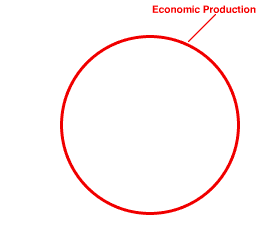 |
The circle in this exhibit represents all economic production in the economy. This is what GDP seeks to measure--the current production of final goods and services. In a perfect world, this is what GDP would actually measure. Of course, the world is NOT perfect and measuring this economic production circle directly is not likely to happen.In the imperfect real world, GDP estimates the economic production activity contained in this circle starting with market transactions--the buying and selling of assorted commodities. This is a great place to start in the assessment of market value. Market transactions are another set of activities that can be represented by a circle. Click the [Market] button to reveal this circle. Note that these two circles do not coincide. They overlap a great deal, but not totally. While much of the economic production circle lies within the market transaction circle, each circle has a slice not contained in the other. These slices provide insight into the measurement of GDP. Past and Future| Past and Future | 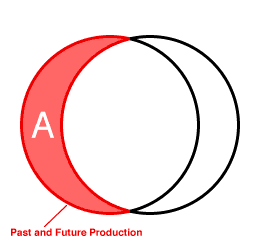 |
The first adjustment is market transactions that are NOT economic production. This is designated as slice "A" in the exhibit to the right. Because this does not contain economic production, it is not part of gross domestic product. Slice "A" contains two categories of stuff--past production and future production.- Past Production: Past production includes used cars, used houses, rummage sale items, and any good produced before the start of the current time period. These items also involve market transactions, but not for current production. If GDP measured the value of all market transactions, then it would include this past production. But these used items are not part of GDP. They are not current production. They are past production. They were already included in GDP in a previous year. So, poof. They are gone.
- Future Production: Intermediate goods are items that WILL become part of GDP in the future, once the finished product is finished. But market transactions for these intermediate goods do not involve current production, which places them in slice "A." If this slice was included in GDP, then double counting occurs. So these market transactions are excluded. Poof. They too are gone.
Slice "A" is excluded from GDP.Estimated Value| Estimated Value | 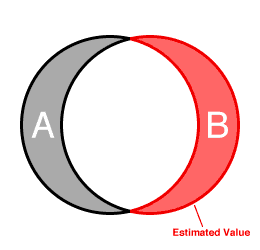 |
A significant amount of economic production that should be included in GDP does NOT involve market transactions. This area is labeled "B" in the exhibit to the right. This really, really should be included, if possible. Some can be and some cannot. Consider first the "can" part.Although by its very nature market value information for nonmarket economic production is lacking, it is possible to come up with reasonable estimates... for some of this activity. Two examples are in-kind payments and services of owner-occupied housing. - In-Kind Payments: Some businesses provide in-kind payments to their owners or employees. A farm family, for example, might sell most of its tomato crop through a market, placing this production squarely in GDP, but it might also consume a few ripe ones right on the farm. No market transaction. No record of value. And possibly escaping inclusion in GDP. However, the official GDP number collectors are able to include the estimated values of many of these in-kind payments in GDP.
- Owner-Occupied Housing: Another estimated production is services provided by owner-occupied housing. For example, suppose Pollyanna Pumpernickel rents a 2,000 square foot house from someone else. Her monthly rental payment is a market transaction which measures the value of the housing services provided, and is included in GDP. But what if someone else, like Duncan Thurly, owns his own house outright and does not make a payment? No market transaction. No record of value. And possibly escaping inclusion in GDP. Once again GDP calculators estimate the value of the services of these owner-occupied houses for inclusion in GDP.
At least part of slice "B" is included in GDP.Home Production| Home Production | 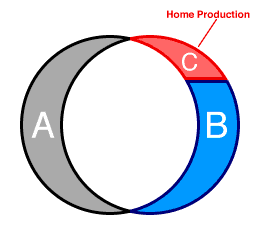 |
While part of slice "B" makes it into GDP, part does not. Some items in this "B" slice cannot be easily estimated and included in GDP. This chunk is labeled "C" in the adjoining exhibit. This chunk of nonmarket economic production includes "productive" activities performed around the house, such as cooking, cleaning, home repairs, and even entertainment. If, for example, Winston Smythe Kennsington III hires a cook or maid to prepare meals and keep his house tidy, then payments for these services are in GDP. These are market transactions. If, however, Gerald Cheverhold prepares his own meals and does his own cleaning, without paying himself, then there are no market transactions and, most important, there are no records that could be used to estimate production.While, in principle, the information needed to estimate the value of this "home production" can be collected, the task is enormous. To do so, the government data collectors would need to keep track of every meal cooked, every window washed, every good produced, and every service performed in every household in the country. So, chunk "C" is excluded from GDP. Illegal Goods| Illegal Activities | 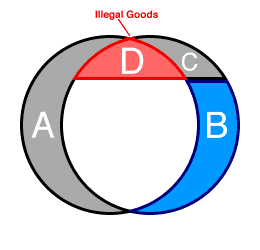 |
Another notable wedge is excluded from GDP for reasons similar to that of household production. This wedge is actually part of the middle section of overlapping circles of economic production and market transactions, which is labeled "D" in this exhibit.It might appear that this is just the sort of thing that would be included in GDP. And normally, it is. But, the lack of information and records of market transactions prevent this wedge "D" from becoming part of GDP. The best example of wedge "D" is illegal activities--gambling, drugs, prostitution, and more. These activities are economic production, they satisfy consumers wants and needs, and they involve market transactions. But because they are illegal, "official" records are not available. Few drug dealers are inclined to report annual sales to the government to ensure that GDP is accurately measured. Wedge "D" is excluded from GDP. GDP| GDP | 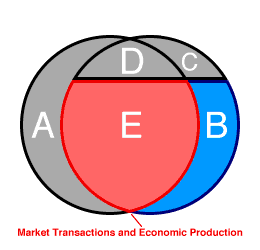 |
This discussion has worked its way down the alphabet to area "E," the overlapping parts of the economic production circle and the market transaction circle, excluding wedge "D." Area "E" is presented in the adjacent exhibit. This is an ideal candidate for GDP. It is economic production. It is market transactions. What more could anyone want?Well, actually nothing. This area forms the foundation of GDP. When the number crunchers start measuring GDP, they start here. This is the easy part, the heart of GDP. Duncan Thurly buys a hot fudge sundae, that is part of GDP. Jonathan McJohnson buys a new car, that too is part of GDP. To summarize, the measurement of GDP begins with all market transactions of record. Past and future production in slice "A" is immediately tossed out. Then the estimated value of nonmarket production in slice "B" is included. While the value of nonmarket production in chunk "C" should be included, sadly such is not possible. And while the value of illegal production from wedge "D" should be included, it too falls through the measurement cracks. The final GDP tabulation is then the combined area "B" and "E." This is GDP. To highlight this area, click the [GDP] button.

Recommended Citation:GROSS DOMESTIC PRODUCT, INS AND OUTS, AmosWEB Encyclonomic WEB*pedia, http://www.AmosWEB.com, AmosWEB LLC, 2000-2024. [Accessed: July 26, 2024].
Check Out These Related Terms... | | | | | | | | | |
Or For A Little Background... | | | | | | | | | |
And For Further Study... | | | | | | | | | | |
Search Again?
Back to the WEB*pedia
|



|

|
YELLOW CHIPPEROON
[What's This?]
Today, you are likely to spend a great deal of time at a crowded estate auction wanting to buy either a coffee cup commemorating the first day of spring or a printer that works with your stockpile of ink cartridges. Be on the lookout for florescent light bulbs that hum folk songs from the sixties.
Your Complete Scope
This isn't me! What am I?
|

|
|
The portion of aggregate output U.S. citizens pay in taxes (30%) is less than the other six leading industrialized nations -- Britain, Canada, France, Germany, Italy, or Japan.
|

|
|
"Old age isn't so bad when you consider the alternative. " -- Cato, Roman orator
|

|
OPEC
Organization of Petroleum Exporting Countries
|

|
|
Tell us what you think about AmosWEB. Like what you see? Have suggestions for improvements? Let us know. Click the User Feedback link.
User Feedback
|


|


